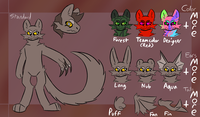Battlebeast Species Ref
VenusianCoda
- Created
- 7 months, 25 days ago
- Creator
- VenusianCoda
- Favorites
- 5
Profile
Origins -
Bioengineered in Downpour by Raincloud for war and defense purposes. Over the years the genetic mold of the Battlebeasts has been replicated and distributed between other corporations and underground fighting rings.
Culture -
As a species defined by their being mass produced and sold the Battlebeasts as a whole do not have a long cultural history, many just adopting the culture of the area where they work and live. The species as a whole is regarded as very adaptable both physically and culturally.
Older Battlebeast survivors of wars do tend to gather in certain areas where they were deployed and left behind when they were no longer needed, these battlebeasts usually share a culture of remembering those lost in the war and celebrating those who survived it.
Religion - Battlebeasts as a whole won’t worship any one single god or pantheon, many worship whatever their owners or community does. In Downpour where they originate this is often [Head God] or members of [their] pantheon.
Art - Freed Battlebeast art often depicts scenes of freedom, open fields, forests, lakes with large gatherings of battlebeasts celebrating. Some art depicts the atrocities of war or the slavery and brutality of the fighting rings.
Occupations - Battlebeasts are usually at the whimsy of their owners as to what jobs they will take on and freed Battlebeasts must take whatever is given to them as it can be hard to find a job when most people see you as a violent animal. Usually hard labor like construction advertises to Battlebeasts as they are naturally quite strong and durable but many Battlbeasts find themselves injured or killed due to their employees overestimating how much they can take on.
Appearance -
Their appearance was engineered to be customizable, leading different armies to give their own troops uniform colors and patterns for recognizability, and fighting rings to give each fighter distinct patterns for recognizability, marketability, and spectacle.
They tend to have sharp claws and fangs, as well as being furred. Their bodies are built for strength overall, with many of their more aesthetic features being customizable, such as ears, tails, colors, and patterns. For example: Aquatic customizations may have fins in place of ears, and a shark-like tail, while still having fur and claws like most battlebeasts. Some are also known to be grown with horns.
Biology -
Their biology is designed for strength and customization, and adaptability above all. Their legs engineered to run fast, their endurance a natural high, typically able to survive long periods of time without food or rest. Their wounds heal quicker than most, but scarring is still present, as it is with most species. As they are made for combat, their claws remain extended on most customizations, but some choose to have their battlebeasts with the ability to retract them. Regardless of any of this, their claws are near unbreakable, razor sharp, and their skin is tough like natural armor.
Reproduction -
Battlebeasts can reproduce sexually and have two sexes, male and female. With intersex conditions existing within the species.
A Battlebeast female will carry the young for 3 months before giving birth to 1-3 live premature young. This is a feature implemented by Downpour in their biology to get them back onto the battlefield quickly after reproducing. Young must be taken care of in special artificial wombs and growth vats so they do not die or grow weak.
Battlebeast young when they grow to be a year old will start developing strong muscles and their temperament will change to a more violent and defensive one, this is when most conditioning for war and otherwise will begin. Freed Battlebeasts will also often teach their children the value of being able to defend themselves.
Battlebeasts lifespan averages around 90 years old, hitting puberty at 10 years old and mentally maturing around 20 years old.
Genetics -
Battlebeast genetics are highly customizable and are able to pass down anything they’re modified with.
All Battlebeasts are able to breed with each other and most other species. Hybrids will usually grow as large as an average Battlbeast, often outgrowing their other parent. They will be naturally muscular and durable. Their outward appearance varies greatly, usually favoring the other parent due to Battlebeasts’ engineered adaptability.
